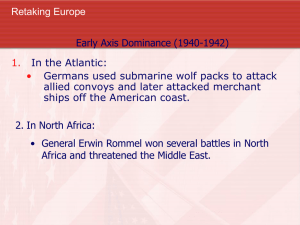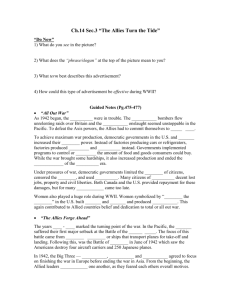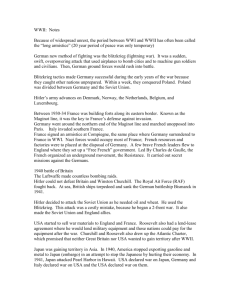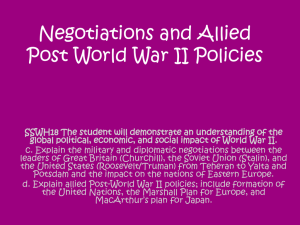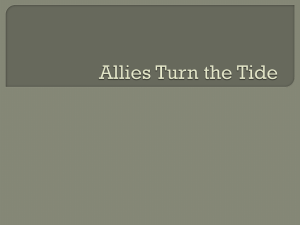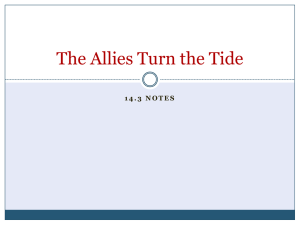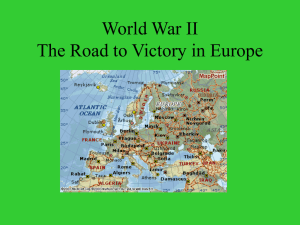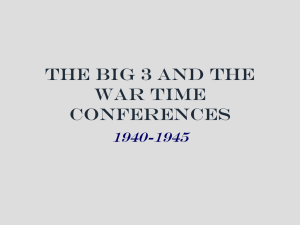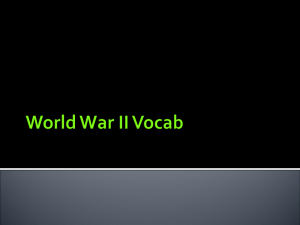The Allies Turn the Tide
advertisement
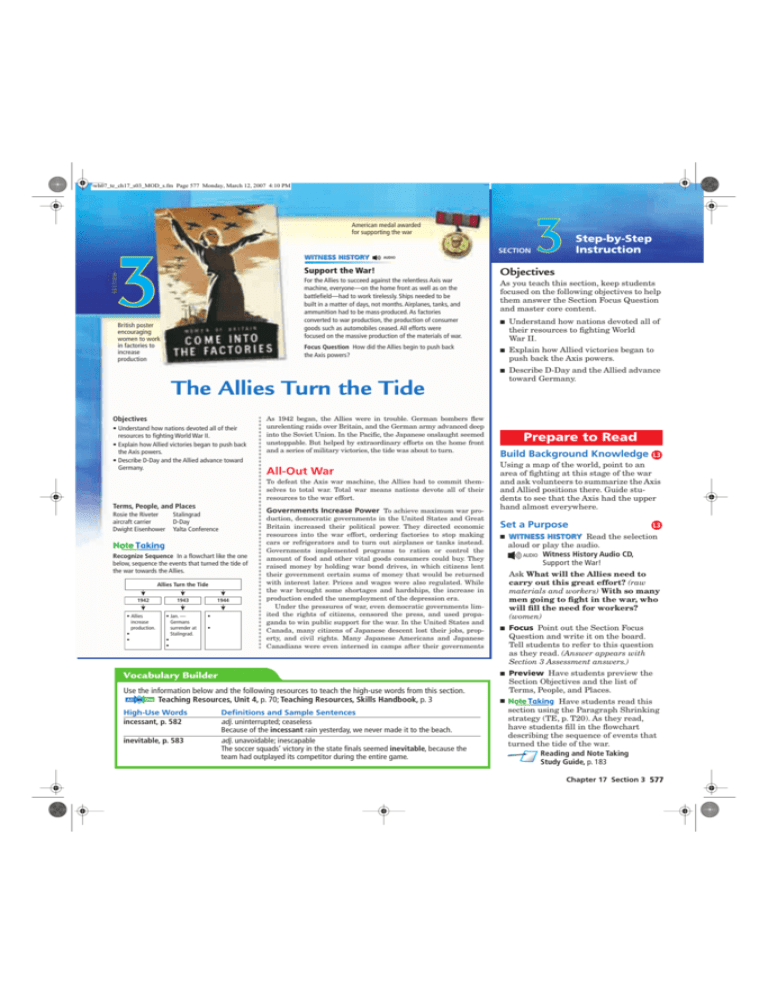
wh07_te_ch17_s03_MOD_s.fm Page 577February Monday, March 12, WH07MOD_se_CH17_s03_s.fm Page 577 Friday, 2, 2007 3:43 PM 2007 4:10 PM American medal awarded for supporting the war WITNESS HISTORY 3 SECTION AUDIO Support the War! For the Allies to succeed against the relentless Axis war machine, everyone—on the home front as well as on the battlefield—had to work tirelessly. Ships needed to be built in a matter of days, not months. Airplanes, tanks, and ammunition had to be mass-produced. As factories converted to war production, the production of consumer goods such as automobiles ceased. All efforts were focused on the massive production of the materials of war. British poster encouraging women to work in factories to increase production Focus Question How did the Allies begin to push back the Axis powers? Objectives As you teach this section, keep students focused on the following objectives to help them answer the Section Focus Question and master core content. ■ Understand how nations devoted all of their resources to fighting World War II. ■ Explain how Allied victories began to push back the Axis powers. ■ Describe D-Day and the Allied advance toward Germany. The Allies Turn the Tide Objectives • Understand how nations devoted all of their resources to fighting World War II. • Explain how Allied victories began to push back the Axis powers. • Describe D-Day and the Allied advance toward Germany. As 1942 began, the Allies were in trouble. German bombers flew unrelenting raids over Britain, and the German army advanced deep into the Soviet Union. In the Pacific, the Japanese onslaught seemed unstoppable. But helped by extraordinary efforts on the home front and a series of military victories, the tide was about to turn. All-Out War To defeat the Axis war machine, the Allies had to commit themselves to total war. Total war means nations devote all of their resources to the war effort. Terms, People, and Places Rosie the Riveter aircraft carrier Dwight Eisenhower Stalingrad D-Day Yalta Conference Recognize Sequence In a flowchart like the one below, sequence the events that turned the tide of the war towards the Allies. Allies Turn the Tide 1942 • Allies increase production. • • 1943 • Jan. — Germans surrender at Stalingrad. • • 1944 • • Governments Increase Power To achieve maximum war production, democratic governments in the United States and Great Britain increased their political power. They directed economic resources into the war effort, ordering factories to stop making cars or refrigerators and to turn out airplanes or tanks instead. Governments implemented programs to ration or control the amount of food and other vital goods consumers could buy. They raised money by holding war bond drives, in which citizens lent their government certain sums of money that would be returned with interest later. Prices and wages were also regulated. While the war brought some shortages and hardships, the increase in production ended the unemployment of the depression era. Under the pressures of war, even democratic governments limited the rights of citizens, censored the press, and used propaganda to win public support for the war. In the United States and Canada, many citizens of Japanese descent lost their jobs, property, and civil rights. Many Japanese Americans and Japanese Canadians were even interned in camps after their governments Vocabulary Builder Use the information below and the following resources to teach the high-use words from this section. Teaching Resources, Unit 4, p. 70; Teaching Resources, Skills Handbook, p. 3 High-Use Words incessant, p. 582 inevitable, p. 583 Definitions and Sample Sentences adj. uninterrupted; ceaseless Because of the incessant rain yesterday, we never made it to the beach. adj. unavoidable; inescapable The soccer squads’ victory in the state finals seemed inevitable, because the team had outplayed its competitor during the entire game. 3 Step-by-Step Instruction Prepare to Read Build Background Knowledge L3 Using a map of the world, point to an area of fighting at this stage of the war and ask volunteers to summarize the Axis and Allied positions there. Guide students to see that the Axis had the upper hand almost everywhere. Set a Purpose ■ L3 WITNESS HISTORY Read the selection aloud or play the audio. AUDIO Witness History Audio CD, Support the War! Ask What will the Allies need to carry out this great effort? (raw materials and workers) With so many men going to fight in the war, who will fill the need for workers? (women) ■ Focus Point out the Section Focus Question and write it on the board. Tell students to refer to this question as they read. (Answer appears with Section 3 Assessment answers.) ■ Preview Have students preview the Section Objectives and the list of Terms, People, and Places. ■ Have students read this section using the Paragraph Shrinking strategy (TE, p. T20). As they read, have students fill in the flowchart describing the sequence of events that turned the tide of the war. Reading and Note Taking Study Guide, p. 183 Chapter 17 Section 3 577 wh07_te_ch17_s03_MOD_s.fm Page 578 Monday, March 12, 2007 4:11WH07MOD_se_CH17_s03_s.fm PM Page 578 Tuesday, June 20, 2006 4:00 PM decided that they were a security risk. The British took similar action against German refugees. Some 40 years later, both the United States and Canada provided former internees with reparations, or payment for damages, but for many the compensation came too late. Teach All-Out War L3 Women Help Win the War As men joined the military, millions of Instruct ■ Introduce Display Color Transparency 176: World War II Poster. Have students also look at the British poster on the previous page. Discuss how posters, advertisements, and movies helped to instill patriotism and a desire to cooperate in the war effort. Color Transparencies, 176 ■ Teach Ask Why would Britain and the United States need to ration, or limit, the amount of consumer goods available? (to preserve supplies for the war effort) What impact did increased production have on the economy? (It finally ended the depression.) ■ Quick Activity Ask Why did Allied governments intern people with Japanese and German ancestry in camps? (from fear that they were security risks) Using the Numbered Heads strategy (TE, p. T23), ask students to discuss the following: In times of war, does a government have the right to take away civil liberties? Independent Practice Have students take the role of an American woman who has entered the workforce for the first time and write a letter to a male relative in the army. Have them explain why they wanted to work. women around the world replaced them in essential war industry jobs. Women, symbolized by the character “Rosie the Riveter” in the United States, built ships and planes and produced munitions. British and American women served in the armed forces in many auxiliary roles—driving ambulances, delivering airplanes, and decoding messages. In occupied Europe, women fought in the resistance. Marie Fourcade, a French woman, helped downed Allied pilots escape to safety. Soviet women served in combat roles. Soviet pilot Lily Litvak, for example, shot down 12 German planes before she herself was killed. How did the Allies mobilize all of their resources for the war effort? The Allies Forge Ahead The years 1942–1943 marked the turning point of the war. The Allies won victories on four fronts—the Pacific, North Africa and Italy, the Soviet Union, and France—to push back the Axis tide. Japanese Navy Battered In the Pacific, the Japanese suffered their Air War in the Pacific Allied forces won decisive victories in the Coral Sea and at Midway Island. The Japanese pilots below may have taken part in these battles, which were fought from planes launched from aircraft carriers. How do you think aircraft carriers changed naval warfare? Alaska (U.S.) Sea of Japan Aleutian Isla JAPAN Haw aiia n converted factories from making consumer goods to making airplanes, tanks, and ships; rationed goods; regulated wages and prices; worked to recruit all members of society to the war effort Caption Sample: Naval warfare became less predictable; enemy ships no longer had to be very close to each other to engage in battle. 578 World War II and Its Aftermath Guadalcanal Coral Sea AUSTRALIA n ds Isla nds Pearl Harbor Pac i f i c O cean a l Se Answers New Guinea ra Co As students complete their flowcharts, circulate to make sure they correctly identify and sequence the key events. For a completed version of the flowchart, see Note Taking Transparencies, 186 The Big Three Plot Their Strategy After the United States entered the war, the Allied leaders met periodically to hammer out their strategy. Midway Tokyo Monitor Progress first serious setback at the Battle of the Coral Sea. The battle lasted for five days in May 1942. For the first time in naval history, the enemy ships never even saw each other. Attacks were carried out by planes launched from aircraft carriers, or ships that transport aircraft and accommodate the take-off and landing of airplanes. The Japanese were prevented from seizing several important islands. More importantly, the Americans sank one Japanese aircraft carrier and several cruisers and destroyers. This Allied victory was followed by an even more impressive win at the Battle of Midway in June 1942, which was also fought entirely from the air. The Americans destroyed four Japanese carriers and more than 250 planes. The battle was a devastating blow to the Japanese. After Midway, Japan was unable to launch any more offensive operations. History Background Social Impact of War To meet the needs of total war, Americans of all backgrounds joined the armed forces. Filipino and Korean Americans were especially eager to fight, not only to aid the Allied effort, but also to liberate their homelands from Japanese conquest. African Americans were initially limited to support roles, but soon were given the opportunity to fight in combat. African American soldiers went on to win nearly 800 medals. The war also provided new opportunities at home. At first, defense industries did not want to hire African Americans. In 1942, President Roosevelt issued Executive Order 8802, which banned discrimination in job training programs and in defense industries. He also set up the Fair Employment Practices Committee, to review charges of job discrimination. By the end of the war, nearly two million African Americans worked in defense factories. wh07_te_ch17_s03_MOD_s.fm Page 57928,Monday, wh07_se_ch29_s03_s.fm Page 579 Friday, October 2005 9:48March AM 12, 2007 3:36 PM INFOGRAPHIC The Allies Forge Ahead L3 Instruct Deadlier bombs, machines that broke secret codes, dive-bombers—all of these technologies gave those who used them a military advantage. Scientists and engineers on both sides of World War II created and improved technologies at a fast and furious pace in a desperate effort to win the war. ■ Introduce: Key Terms Have students find the key term aircraft carrier (in blue) in the text. Point out that Japan was more than 3,000 miles from some of its conquests in Southeast Asia. Ask Why do you think aircraft carriers were such a vital part of the war effort? (Sample: Large fleets were needed to move airplanes, troops, and supplies around the vast area of the Pacific.) ■ Teach Have students refer to the map of the Pacific theater in Section 4 and locate the Battles of Coral Sea and Midway. Then have them refer to the map of the European theater on the next spread to see the location of El Alamein, the points where Italy was invaded, and the site of Stalingrad. Ask How did these battles turn the tide for the Allies? (Midway and the Coral Sea badly damaged Japanese power, preventing Japan from launching any further offensive operations. El Alamein and Stalingrad stopped the Axis powers at their farthest advance. The invasion of Italy was the first assault on the Axis’ homelands.) ■ Analyzing the Visuals To help students visualize the battle of Stalingrad, display Color Transparency 177: Battle of Stalingrad. Ask a volunteer to read the description of the battle from the text. As the student reads each sentence, point to the map to show where the action took place. Then use the lesson suggested in the transparency book to guide a discussion. Color Transparencies, 177 Nylon replaced 䉴 silk as a lightweight material used to make parachutes. 䉳 Radar uses the behavior of electromagnetic waves to detect objects. It helped defenders to “see” and destroy planes before they could reach their targets. 䉲 Improved sonar technology allowed submarines to use sound waves underwater to “see” enemy submarines. Thinking Critically 1. Draw Conclusions Radar helped the British win the Battle of Britain. Explain why it made such a difference. 2. Determine Relevance How did Hitler use technology in his blitzkrieg tactics? In 1942, the “Big Three”—Roosevelt, Churchill, and Stalin—agreed to focus on finishing the war in Europe before trying to end the war in Asia. From the outset, the Allies distrusted one another. Churchill and Roosevelt feared that Stalin wanted to dominate Europe. Stalin believed the West wanted to destroy communism. None of the new Allies wanted to risk a breakdown in their alliance, however. At a conference in Tehran, Iran, in late 1943, Churchill and Roosevelt yielded to Stalin by agreeing to let the borders outlined in the Nazi-Soviet Pact stand, against the wishes of Poland’s government-in-exile. However, Stalin also wanted Roosevelt and Churchill to open a second front against Germany in Western Europe to relieve the pressure on the Soviet Union. Roosevelt and Churchill replied that they did not yet have the resources. Stalin saw the delay as a deliberate policy to weaken the Soviet Union. Allied Victory in North Africa In North Africa, the British led by General Bernard Montgomery fought Rommel. After the fierce Battle of El Alamein in November 1942, the Allies finally halted the Desert Fox’s advance. Allied tanks drove the Axis back across Libya into Tunisia. Later in 1942, American General Dwight Eisenhower took command of a joint British and American force in Morocco and Algeria. Advancing on Tunisia from the west, the Allies trapped Rommel’s army, which surrendered in May 1943. Link to Math The Enigma Code Intelligence work helped produce the American victory at Midway—and that work owed its success in part to a Polish mathematician. In the 1930s, the Germans developed a machine called Enigma that allowed them to put military communications in code. Polish mathematician Marian Rejewski led a team that cracked the code. The Polish team gave their information to the British, who developed a new device that decoded messages created by a revised version of Enigma. The Germans had given an Enigma machine to the Japanese, and the Americans created their own machine to decode it. As a result, American naval intelligence officers intercepted Japanese plans to attack Midway. That allowed the navy to have a fleet lying in wait to beat back the Japanese attack. Answers Thinking Critically 1. because it allowed the British to know when German planes were coming and where they were going 2. Improved aircraft and tank technology helped Hitler to overwhelm his opponents. Chapter 17 Section 3 579 wh07_te_ch17_s03_MOD_s.fm Page 580 Monday, March 12, 2007 3:36WH07MOD_se_CH17_s03_s.fm PM Page 580 Tuesday, June 20, 2006 4:01 PM Allies Advance Through Italy Independent Practice ■ Have students fill in the Outline Map Europe and North Africa. Teaching Resources, Unit 4, p. 77 ■ Have students access Web Code nbp2931 to take the Geography Interactive Audio Guided Tour and then answer the map skills questions in the text. Monitor Progress ■ ■ Have students write a brief paragraph explaining why Churchill, Roosevelt, and Stalin cooperated during the war, what agreements they reached in their 1942 conference, and what factors caused problems among them. The Pain of Defeat German prisoners are marched through the snowy streets of Stalingrad after their defeat by the Soviet army. With North Africa under their control, the Allies were able to cross the Mediterranean into Italy. In July 1943, a combined British and American army landed first in Sicily and then in southern Italy. They defeated the Italian forces there in about a month. After the defeats, the Italians overthrew Mussolini and signed an armistice, but fighting did not end. Hitler sent German troops to rescue Mussolini and stiffen the will of Italians fighting in the north. For the next 18 months, the Allies pushed slowly up the Italian peninsula, suffering heavy losses against strong German resistance. Still, the Italian invasion was a decisive event for the Allies because it weakened Hitler by forcing him to fight on another front. Germans Defeated at Stalingrad A major turning point occurred in the Soviet Union. After their lightning advance in 1941, the Germans were stalled outside Moscow and Leningrad. In 1942, Hitler launched a new offensive. This time, he aimed for the rich oil fields of the south. His troops, however, got only as far as Stalingrad. The Battle of Stalingrad was one of the costliest of the war. Hitler was determined to capture Stalin’s namesake city, and Stalin was equally determined to defend it. The battle began when the Germans surrounded the city. As winter closed in, a bitter street-by-street, house-by-house struggle raged. A German officer wrote that soldiers fought for two weeks for a single building. Corpses “are strewn in the cellars, on the landings and the staircases,” he said. In November, the Soviets encircled their attackers. Trapped, without food or ammunition and with no hope of rescue, the German commander finally surrendered in January 1943. After the Battle of Stalingrad, the Red Army took the offensive and drove the invaders out of the Soviet Union entirely. Hitler’s forces suffered irreplaceable losses of both troops and equipment. By early 1944, Soviet troops were advancing into Eastern Europe. Circulate to make sure students have correctly labeled their Outline Maps. Administer the Geography Quiz. Teaching Resources, Unit 4, p. 79 How did the Allies push back the Axis powers on four fronts? The Allies Push Toward Germany By 1944, the Western Allies were at last ready to open a second front in Europe by invading France. Allied leaders under Eisenhower faced the enormous task of planning the operation and assembling troops and supplies. To prepare the way for the invasion, Allied bombers flew constant missions over Germany. They targeted factories and destroyed aircraft that might be used against the invasion force. They also bombed railroads and bridges in France. The D-Day Assault The Allies chose June 6, 1944—known as D-Day— for the invasion of France. Just before midnight on June 5, Allied planes dropped paratroopers behind enemy lines. Then, at dawn, thousands of ships ferried 156,000 Allied troops across the English Channel. The troops Solutions for All Learners Answer Midway blocked the Japanese advance in the Pacific. El Alamein was the beginning of the end of German control of North Africa. The invasion of Italy attacked one of the Axis home lands. Stalingrad destroyed a large German army in the east. 580 World War II and Its Aftermath L2 Less Proficient Readers Tell students that many historians consider the Battle of Stalingrad to be the key turning point in World War II. Work with students to help them to find reliable internet sources and grade-level reference sources about the battle. Then challenge them to describe or illustrate one of the aspect battle—for example, the military movements or daily life in the city. Use the following resources to help students acquire basic skills. Adapted Reading and Note Taking Study Guide ■ Adapted Note Taking Study Guide, p. 183 ■ Adapted Section Summary, p. 184 wh07_te_ch17_s03_MOD_s.fm Page 581 June Monday, 12, WH07MOD_se_CH17_s03_s.fm Page 581 Tuesday, 20, 2006March 4:01 PM 2007 3:38 PM For: Interactive map and timeline Web Code: nbp-2931 World War II in Europe and North Africa, 1942–1945 Map Skills Axis power reached its height in Europe in 1942. Then the tide began to turn. 1. Locate (a) Vichy France (b) Soviet Union (c) El Alamein (d) Normandy (e) Berlin The Allies Push Toward Germany 2. Place Describe the extent of Axis control in 1942. 3. Make Inferences How did geography both help and hinder Allied advances? Instruct ■ Introduce: Vocabulary Builder Have students read the Vocabulary Builder terms and definitions. Give them the following sentence and ask which term would best fill in the blank to complete the sentence: The attacks on German cities were repeated against Japan. (incessant) ■ Teach Ask Why did the Americans and British wait until 1944 to invade France? (They said they were not ready until then.) How long did it take the Allied forces to liberate Paris and all of France? (about two and half months to regain Paris and another month to free the rest of France) What kinds of targets did the Allies bomb in Germany in 1944? (military bases, factories, railroads, oil depots, and cities) Why was it important for the Allied leaders to meet early in 1945? (They were closing in on Germany from both sides by that time, and the war in Europe was nearing an end; they had to agree on the strategy to end the war and on post-war arrangements.) ■ Quick Activity Show students Triumph at Normandy from the Witness History Discovery School™ video program. Ask volunteers to describe some of the planning and resources needed to carry out the D-Day invasion of Normandy. 70° N Europe Axis powers, 1942 10° E Maximum Axis control, 1942 Neutral nations, 1942 Allied territory, 1942 FINL Allied advances AND SWEDEN Major battles 0° d ngra Leni N O R W AY 60° N Ba Danzig Elbe R 1945 . London Atla n Oce tic an 50° N NETH. Dunkirk BELGIUM N or m a n dy 1 94 LUX. 1944 5 Berlin 1945 194 2 UG AL 40° N 1944 I T A LY Rome Anzio PORT S PA I N 1944 42 19 MOR 200 Jan 1943 Germans surrender at Stalingrad Bl 400 mi a Yalt Sea k ac L I B YA Jul 1943 Allied forces land in Sicily 1944 Sep 1943 Italians surrender to Allies RK EY SYR E Le Tripoli Tunisia (F R. ) 400 km 3 N W 1 94 2 194 3 d gra E ea an S rane k Medite r Tobru 1943 Nov 1942 British defeat Germans at El Alamein IA TU GREEC Jan 1945 Soviets enter Warsaw 1945 Jun 6, 1944 D-Day invasion at Normandy N 43 19 S OCCO 0 194 I O lin Sta 1943 1943 1 94 2 0 1942 Tunis Algeria (F R . ) Oran Conic Projection 200 AN ROM . 4 194 Sicily Algiers Casabla nca st Budape ALB. Salerno Palermo Spanish Morocco 44 19 be R Danu BIA R A E I S T A O R C ARIA MONT. BULG 4 194 Vi c hy Fra n c e Y HUNGAR E T V I k Kurs GERMANY 45 19 IA Rhine R. SLOVAK SWITZ. S O 43 19 44 19 w Warsa 1944 1945 Paris FRANCE Vichy 45 19 N on ban s Pa le n amei El A l EGY (FR tine .) (BR o Cair IA .) Q IRA .) FR n( l ti DENMARK U Transjorda IRELA ND UNITED KINGD OM Nor th Sea cS ea w sco Mo 10° W L3 DI S AU B I A A AR PT May 7, 1945 Germany surrenders 1946 Mar 1945 British and American forces cross Rhine Answers Map Skills Careers Cartographer Mapmakers, or cartographers, make maps that show geographic data—latitude and longitude, the distance between objects, and the height or depth of physical features—or other data, such as political boundaries, the location of economic resources, and living patterns. They usually learn their skills by taking a college degree. They also need strong computer skills. Mapping technicians help cartographers carry out their work. They turn information taken from observations of the land into data that can be incorporated onto maps. These workers need less training than cartographers, and the demand for them is expected to grow more rapidly than for cartographers in the future. However, they earn less than people in cartography, which is considered a more advanced career. 1. Review locations with students. 2. The Axis controlled all of Eastern and Western Europe except the neutral nations (Sweden, Ireland, Portugal, Spain, and Switzerland) and the United Kingdom, which was fighting them. They also controlled the western part of the Soviet Union and almost all of North Africa. 3. helped: They could attack Germany from all sides; hindered: The Americans and British had to move resources through the Atlantic to North Africa and southern Europe. Chapter 17 Section 3 581 wh07_te_ch17_s03_MOD_s.fm Page 582 Monday, March 12, 2007 3:38 PMWH07MOD_se_CH17_s03_s.fm Independent Practice ■ Have each student select one of the three leaders, Churchill, Stalin, or Roosevelt. Have them learn more about this leader and then write an obituary, which summarizes his role and achievements during World War II. ■ Have students take the role of a soldier who fought at D-Day and write a letter to family members back home describing the experience. Monitor Progress ■ Have students create an outline of the subsection The Allies Push Toward Germany that organizes and highlights the key points. ■ Check Reading and Note Taking Study Guide entries for student understanding. Page 582 Tuesday, June 20, 2006 4:01 PM BIOGRAPHY Churchill Winston Churchill (1874–1965) was a staunch antisocialist and defender of the British Empire. As a member of Parliament, he loudly warned the British of the threat posed by Nazi Germany. After Neville Chamberlain’s government failed to defend Norway from Hitler, Churchill replaced him as prime minister on May 10, 1940. Within seven weeks, France had surrendered, and Nazi forces threatened Britain. Churchill’s courage and defiance steeled British resolve in the darkest days of the war when Britain stood alone against the Nazis. How did Churchill inspire the British people? WITNESS HISTORY VIDEO Watch Triumph at Normandy on the Witness History Discovery School™ video program to experience the planning and execution of the D-Day invasion. Roosevelt In 1933, Franklin Delano Roosevelt (1882–1945) started his first term as president, promising to bring the United States out of the Great Depression. During his second term, FDR lent, and then gave, millions of dollars in war supplies to the struggling British. Japan’s attack on Pearl Harbor quickly brought the United States into the war. From the start of American involvement, Roosevelt took the lead in establishing alliances among all countries fighting the Axis powers—including the Soviet Union. How did Roosevelt influence World War II before Pearl Harbor? Stalin Joseph Stalin (1879–1953) was born Joseph Dzhugashvili (joo gush VYEE lyee). He changed his name to Stalin, meaning “man of steel,” after he joined the Bolshevik underground in the early 1900s. Stalin emerged as the sole ruler of the Soviet Union in the 1920s, and he maintained an iron grasp on the nation until his death in 1953. When Hitler’s army invaded the Soviet Union and threatened Moscow in 1941, Stalin refused to leave the capital city. He eventually forced the Germans into retreat. Why would Churchill and Roosevelt have distrusted Stalin? fought their way to shore amid underwater mines and raking machine-gun fire. As one soldier who landed in the first wave of D-Day assault recalled, Primary Source all seemed unreal, a sort of dreaming while awake, men were screaming and “ Itdying all around me. . . I honestly could have walked the full length of the beach without touching the ground, they were that thickly strewn about. ” —Melvin B. Farrell, War Memories Still, the Allied troops clawed their way inland through the tangled hedges of Normandy. In early August, a massive armored division under American General George S. Patton helped the joint British and American forces break through German defenses and advance toward Paris. Meanwhile, other Allied forces sailed from Italy to land in southern France. In Paris, French resistance forces rose up against the occupying Germans. Under pressure from all sides, the Germans retreated. On August 25, the Allies entered Paris. Within a month, all of France was free. Allies Continue to Advance By this time, Germany was reeling under incessant, round-the-clock bombing. For two years, Allied bombers had hammered military bases, factories, railroads, oil depots, and cities. Vocabulary Builder incessant—(in SES unt) adj. uninterrupted, ceaseless Solutions for All Learners Answer BIOGRAPHY Churchill: with his courage and defiant attitude; Roosevelt: He gave supplies and guidance to help the British fight the Nazis; Stalin: because he showed ruthlessness in killing or exiling all his rivals before gaining power and because he had earlier allied himself with Hitler 582 World War II and Its Aftermath L4 Advanced Readers L4 Gifted and Talented Point out that the war saw heavy use of air attacks on cities. Explain that cities often held key military targets, such as factories, railroad depots, bridges, and oil facilities. They also held millions of people, however, and targeting during World War II was not precise. Have students investigate the issue of the bombing carried out during the war and write an essay exploring whether the targeting of cities was justified, not justified, or justified in some cases but not others. Remind students to offer facts as well as well-reasoned arguments to support their opinions. wh07_te_ch17_s03_MOD_s.fm Page 583 June Monday, 12, WH07MOD_se_CH17_s03_s.fm Page 583 Tuesday, 20, 2006March 4:01 PM 2007 3:39 PM The goal of this kind of bombing was to cripple Germany’s industries and destroy the morale of its civilians. In one 10-day period, bombing almost erased the huge industrial city of Hamburg, killing 40,000 civilians and forcing one million to flee their homes. In February 1945, Allied raids on Dresden, not an industrial target, but considered one of the most beautiful cities in Europe, killed as many as 135,000 people. After freeing France, Allied forces battled toward Germany. As their armies advanced into Belgium in December, Germany launched a massive counterattack. At the bloody Battle of the Bulge, which lasted more than a month, both sides took terrible losses. The Germans were unable to break through. The battle delayed the Allied advance from the west, but only for six weeks. Meanwhile, the Soviet army battled through Germany and advanced on Berlin from the east. Hitler’s support within Germany was declining, and he had already survived one assassination attempt by senior officers in the German military. By early 1945, the defeat of Germany seemed inevitable. Uneasy Agreement at Yalta In February 1945, Roosevelt, Churchill, Assess and Reteach Assess Progress ■ Have students complete the Section Assessment. ■ Administer the Section Quiz. ■ To further assess student understanding, use Progress Monitoring Transparencies, 125 L3 Teaching Resources, Unit 4, p. 67 Vocabulary Builder inevitable—(in EV ih tuh bul) adj. unavoidable, inescapable Reteach If students need more instruction, have them read the section summary. Reading and Note Taking L3 Study Guide, p. 184 and Stalin met again at Yalta, in the southern Soviet Union. Once again, the Big Three planned strategy in an atmosphere of distrust. Stalin insisted that the Soviet Union needed to maintain control of Eastern Europe to be able to protect itself from future aggression. Churchill and Roosevelt favored self-determination for Eastern Europe, which would give people the right to choose their own form of government. However, Churchill and Roosevelt needed Stalin’s help to win the war. At the Yalta Conference, the three leaders agreed that the Soviet Union would enter the war against Japan within three months of Germany’s surrender. In return, Churchill and Roosevelt promised Stalin that the Soviets would take possession of southern Sakhalin Island, the Kuril Islands, and an occupation zone in Korea. They also agreed that Germany would be temporarily divided into four zones, to be governed by American, French, British, and Soviet forces. Stalin agreed to hold free elections in Eastern Europe. However, as you will read later, growing mistrust would later cause a split between the Allies. Adapted Reading and L1 L2 Note Taking Study Guide, p. 184 Spanish Reading and L2 Note Taking Study Guide, p. 184 Extend L4 Have students compare the role of American women during World War II to their role in World War I. Encourage them to do additional research to gather information on both periods. What agreements did Churchill, Roosevelt, and Stalin come to at Yalta? Answer 3 Terms, People, and Places 1. For each term, person, or place listed at the beginning of the section, write a sentence explaining its significance. 2. Reading Skill: Recognize Sequence Use your completed timeline to answer the Focus Question: How did the Allies begin to push back the Axis powers? Progress Monitoring Online For: Self-quiz with vocabulary practice Web Code: nba-2931 Comprehension and Critical Thinking 3. Analyze Information How did democratic governments mobilize their economies for war? 4. Determine Relevance Explain why the battles of Midway, El Alamein, and Stalingrad were important turning points in the war. 5. Predict Consequences Why didn’t the Yalta Conference lead to lasting unity among the Big Three leaders? Section 3 Assessment 1. Sentences should reflect an understanding of each term, person, or place listed at the beginning of the section. 2. American air power inflicted heavy losses on the Japanese in the Pacific. The Americans and British combined to drive the Germans out of North Africa and to invade Italy. At the same time, the Soviets defeated the Germans at Stalingrad. ● Writing About History Quick Write: Develop a Thesis A thesis statement summarizes the main idea of your research paper. The thesis statement should express an idea that can be defended or refuted. It should also be narrow enough to be addressed clearly in your writing. Based on what you have read, write a thesis statement for an essay explaining the importance of the Battle of Stalingrad. 3. They directed and controlled economic resources for the war effort, regulated prices and wages, and enlisted the efforts of all their citizens. 4. At Midway, American planes crippled Japanese naval power. El Alamein stopped the German advance in North Africa. Stalingrad allowed the Soviets to take the offensive against the Germans. 5. Mutual mistrust and differing goals and concerns divided the three leaders. Stalin agreed to declare war on Japan in return for gaining land. He also agreed to hold free elections in Eastern Europe after the war. They all agreed to divide Germany into four occupation zones. ● Writing About History Students’ thesis statements should explain why Stalingrad was an important battle. For additional assessment, have students access Progress Monitoring Online at Web Code nba-2931. Chapter 17 Section 3 583
